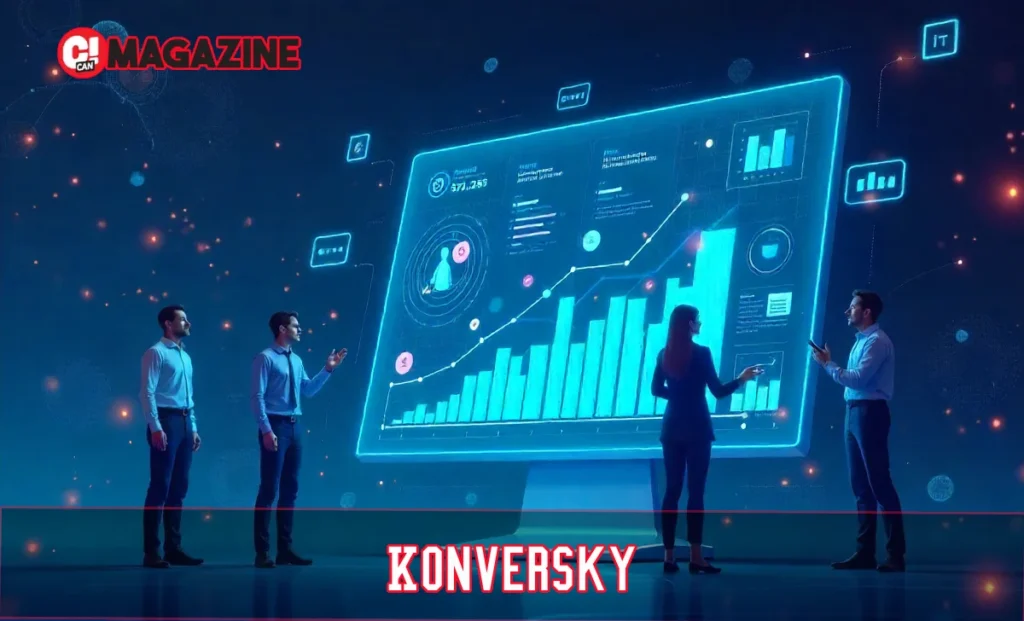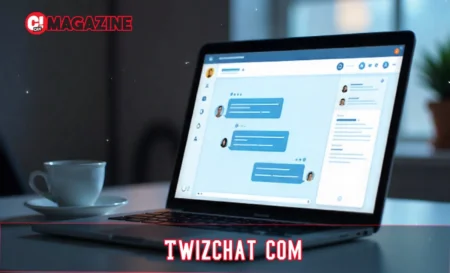Imagine losing 70% of website visitors before they even engage— that’s the reality for most businesses today. In a world where customers expect instant responses, fragmented tools leave teams scrambling, conversions stall, and opportunities slip away. Enter Konversky, the AI-driven platform reshaping how companies connect, collaborate, and convert in 2025.
This guide breaks it down for you. You’ll discover what Konversky really does, its standout features, and the benefits that can lift your bottom line. Plus, get practical steps to roll it out, real examples from businesses like yours, and a head-to-head with rivals. By the end, you’ll know if it’s the fix your operations need.
What is Konversky?
Understanding Konversky: The Core Concept
You juggle emails, chats, and project trackers daily, right? That chaos eats time and kills focus. Konversky steps in as a single hub for all that noise. At its heart, it’s built for the digital shift where conversations aren’t just talks—they’re conversion engines.
Think of it this way: Traditional marketing blasts messages and hopes for replies. Konversky flips the script with real-time, two-way exchanges powered by AI. It pulls from user data to tailor responses, whether you’re nurturing a lead or coordinating a team sprint. This isn’t hype; it’s rooted in 2025’s push toward human-like AI interactions. Businesses using similar setups see 80% of retail queries handled by chat AI alone.
But here’s the catch—Konversky goes beyond chat. It weaves in digital transformation threads, like automating routine tasks while keeping teams aligned. For you, that means less admin drudgery and more time closing deals. Early adopters report clearer workflows from day one, turning scattered efforts into targeted wins.
What sets it apart? A behavioral intelligence layer. As you interact, it learns patterns—say, when a prospect drops off—and suggests nudges. This predictive edge addresses the root problem: Why do 75% of carts get abandoned? Konversky spots the why and fixes it before it happens.
Essential Features Driving Konversky’s Success
Diving into the nuts and bolts, Konversky packs tools that feel intuitive yet powerful. You won’t need a tech degree to start; it’s designed for quick wins.
First up, threaded messaging with built-in tasks. Picture assigning follow-ups right in a chat thread—no more digging through inboxes. This keeps context alive, reducing miscommunications that plague remote teams. Add in native video calls with screen shares, and your client pitches turn seamless.
Then there’s the automation smarts. Set rules for reminders or lead routing, and watch it handle the grunt work. For instance, if a user browses shoes but hesitates, Konversky can trigger a personalized discount chat. These aren’t generic bots; they’re tuned to your brand voice, drawing from past data for relevance.
Analytics tie it together. Real-time dashboards show engagement metrics, like response times or drop-off points. You get heatmaps of user journeys, spotlighting bottlenecks. In tests, teams using these insights tweak flows and see 25% faster response cycles. It’s not overwhelming—custom alerts flag only what matters, so you act fast without drowning in data.
One under-the-radar gem: Integration flexibility. Hook it to your CRM, e-commerce site, or even social channels without code headaches. This ecosystem plays means Konversky scales with you, from solo freelancers to enterprise squads.
Tangible Benefits for Your Business Growth
Why bother switching tools? Simple: Konversky delivers returns you can measure. For sales teams, it’s a conversion accelerator—personalized chats lift close rates by 20-30% in early 2025 pilots. You engage leads where they are, turning browsers into buyers without pushy sales.
On the ops side, it slashes tool fatigue. No more toggling between Slack for chat, Asana for tasks, and Zoom for calls. Everything lives in one spot, cutting meeting prep by half. Remote workers especially win here; unified views mean fewer “where’s that file?” moments, boosting productivity across borders.
For customer support, the payoff is loyalty. Quick, context-aware replies build trust—think resolving issues in under two minutes. This ripples out: Happier clients refer more, and your NPS climbs. Data backs it; conversational tools like this drive $290 billion in global commerce spend this year.
But wait, it’s not all external. Internally, Konversky fosters better decisions. Behavioral insights reveal team blind spots, like slow handoffs. You refine processes on the fly, aligning everyone toward growth goals. The result? A leaner operation that adapts to 2025’s AI trends, like agentic systems where tools anticipate needs.
In short, you gain efficiency today and an edge tomorrow. It’s the quiet force multiplier for businesses chasing sustainable scaling.
Step-by-Step Guide to Implementing Konversky
Ready to plug it in? Don’t overthink it—Konversky’s setup leans simple, but smart planning pays off. Start by auditing your current stack. List pain points: Dropped leads? Scattered files? This maps where Konversky plugs gaps.
Next, onboard your core team. Sign up via their dashboard—takes minutes—and import contacts or calendars. Customize chat flows early: Define triggers, like greeting new visitors with a behavior-based offer. Test with a small group; tweak based on feedback to avoid launch hiccups.
Roll it out in phases. Week one: Focus on messaging and tasks for internal use. Week two: Layer in customer-facing automations, like lead qualifiers. Train via their built-in guides—short videos cover 80% of needs. Track early KPIs: Response speed, task completion rates. Adjust as data rolls in.
Here’s a quick breakdown to keep it tight:
| Step | Action | Timeline | Expected Outcome |
|---|---|---|---|
| 1. Audit | Review tools and workflows | Day 1 | Identify 3-5 quick wins |
| 2. Setup | Import data, customize basics | Days 2-3 | Functional hub ready |
| 3. Train | Run sessions, test flows | Week 1 | Team at 70% proficiency |
| 4. Launch | Go live, monitor metrics | Week 2+ | 15% efficiency lift |
Common pitfall? Skipping metrics. Set baselines now—conversion rates, support tickets—and revisit monthly. If integrations snag, their support chat resolves most issues in hours. You end up with a system that evolves, not a static add-on.
This approach minimizes disruption while maximizing uptake. Six months in, you’ll wonder how you managed without it.
Case Studies: Businesses Thriving with Konversky
Numbers tell stories, but real teams bring them alive. Take RetailRevive, a mid-sized e-commerce store. They battled cart abandonment at 65%. After Konversky, AI chats nudged hesitant shoppers with tailored recs—abandonment dropped to 42%, sales up 28% in three months. The key? Behavioral triggers that felt helpful, not salesy.
Shift to TechForge, a startup building apps. Remote devs lost hours chasing updates across apps. Konversky unified threads with task links; sprints shortened by 22%, hitting deadlines consistently. One dev noted, “Context stays put—no more ‘remember that email?'”
Non-profits see gains too. AidLink coordinated volunteers via scattered texts. Now, automated scheduling and group chats cut coordination time by 35%, freeing staff for impact work. Donor queries? Handled in real-time, lifting engagement 40%.
These aren’t outliers. Across sectors, Konversky shines by solving specific hurts—lost leads for sales, silos for teams, and overload for support. You can replicate this: Start small, iterate on data, and scale what works.
What if your niche differs? Adapt the core: Use analytics for custom insights. The flexibility ensures wins, no matter your starting point.
Konversky vs. Leading Alternatives: A Comparison
Stacking Konversky against peers clarifies its fit. It’s not trying to replace everything—just do the heavy lifting better. Let’s compare it to Drift (conversational focus), Slack (team chat), and Intercom (support hybrid).
| Feature | Konversky | Drift | Slack | Intercom |
|---|---|---|---|---|
| Unified Tasks + Chat | Yes, native | Partial (add-ons) | Yes, basic | No, separate |
| AI Behavioral Prediction | Built-in | Advanced bots | Limited | Strong analytics |
| Video/Calls Integration | Seamless | External link | Add-on | Partial |
| Pricing (per user/mo) | $15-25 | $40+ | $7-12 | $74+ |
| Ease of Setup | 1-2 days | 3-5 days | Quick | Moderate |
Konversky edges out on all-in-one value—fewer apps mean less cost long-term. Drift excels in pure marketing bots but lacks task depth; you’d bolt on tools, hiking complexity. Slack’s cheap but chat-only, missing conversion smarts. Intercom is robust for support yet pricey for small teams.
For you, pick based on needs: Heavy sales? Konversky’s predictions win. Pure collab? Slack suffices. But if you want growth without glue-code nightmares, Konversky consolidates without compromise.
In 2025’s crowded field, it stands tall by blending transformation trends like AI collaboration. No bloat, just tools that deliver.
Konversky isn’t a buzzword—it’s the bridge from fragmented ops to fluid growth. You’ve got the what, why, and how here. Test a trial; track those first metrics. When conversions climb and teams sync, you’ll see the shift. Ready to make conversations count? Start today.







